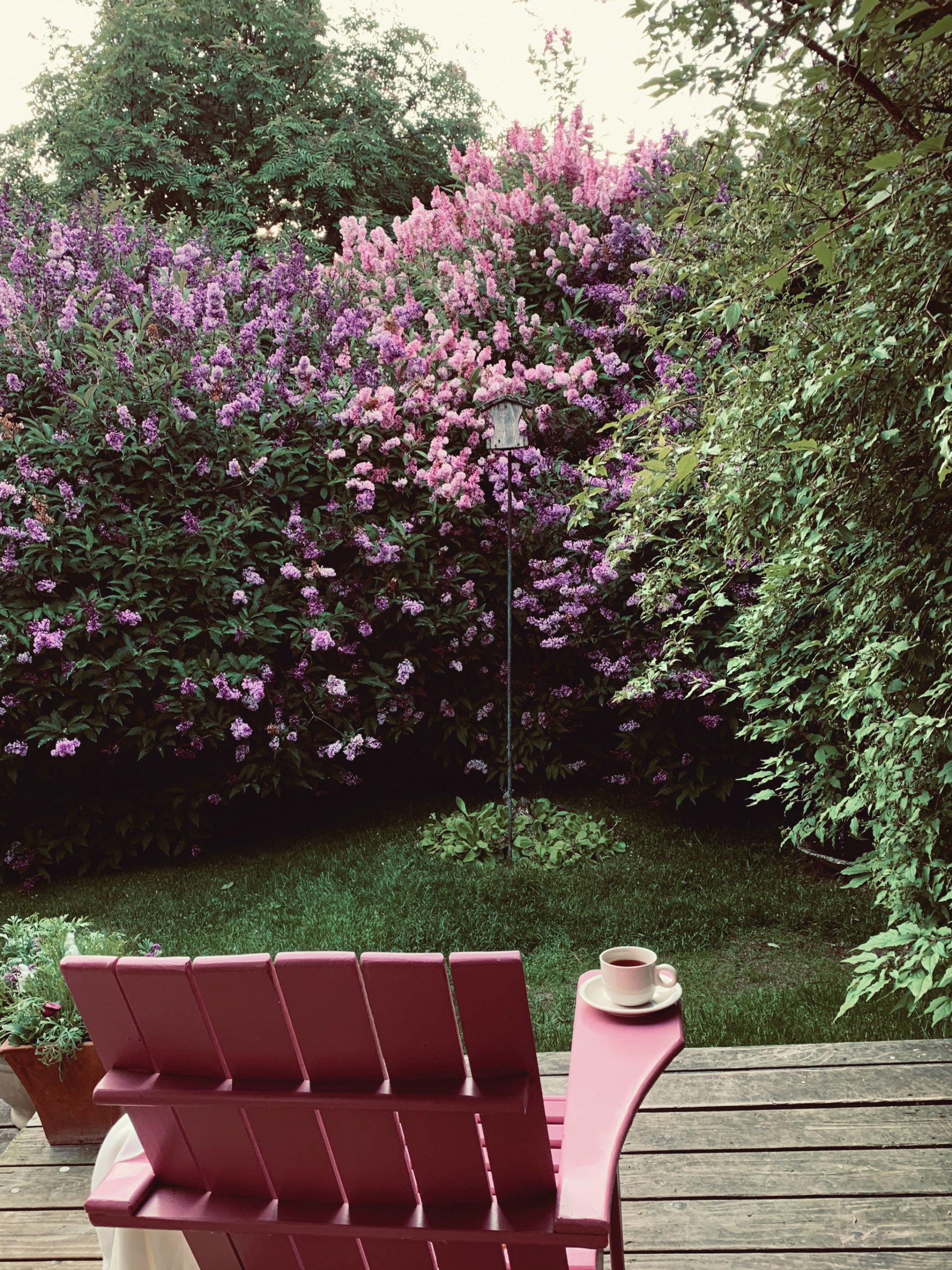There are nine lilacs on this one-third acre and they are blooming in sequence. I actually thought about that — me, who does zero garden planning. The first to go off are the two Donald Wymans (purple) that flank the James MacFarland (pink). They are part of the Canadian series that do so well at our latitude. These three lovelies are right outside the French doors which serve as our side entrance. There is a small deck and this is where the morning tea is savored while watching birds and appreciating lilacs.
Oh, that paragraph is loaded. I’ll attempt to stick to the lilac theme and then move on to the birds. I truly believe that gardening and birding go hand in glove.
As you travel about the area, notice how huge some of the established lilac shrubs are. We have those who came before to thank for their forethought in planting these.
Here on this plot I made the classic mistake of planting them too close to each other. At the time I didn’t really appreciate how sizable these can ultimately become. So there goes my smug planning for color. These three have the potential to reach the house, making the doors impassable. Think about that. This is also where the carousel clothesline is installed. John actually took the steps to pour concrete so the clothesline has a solid base. The lilac on the left is making it almost impossible to rotate the clothesline. So, I asked John to move it. He said, “No.” Hence, I will need to prune. If you find yourself in a similar situation, pruning will happen after the shrub is done blooming. Do it right away because next year’s buds form this summer.
The four dwarf Korean lilacs are in full bloom and their scent fills the entire garden. These are such tidy shrubs and the blooms completely cover the foliage. They are indeed a treat.
The Miss Kim, also a Korean but much smaller and tidier than the Canadians in the East Garden, has decided to make up for last year’s dearth of blooms. She is spectacular. Skirting her base are alchemilla mollis (lady’s mantle) with chartreuse foliage and yellow blooms, a truly lovely combination. Be careful of lady’s mantle — it can spread and get quite out of hand. Be sure to deadhead (cut off spent blooms) and actually cut it back when it is done blooming. It will regrow a nice mound of foliage for the rest of the summer.
On the west corner of the house is a common lilac, stalwart that it is, the first to bloom and lasts a good long time. Just because it has the word “common” attached, don’t underestimate it. Eight years ago I thought it was dead, cut it down to the ground, and it has returned with a vengeance. It almost reaches the roof. Excellent.
Everything on this lot is planted too close. Our traffic patterns are so impinged and I am such a hesitant pruner that we may just find ourselves trapped in a fairy tale sort of way. John, on the other hand, has zero qualms about hacking away at whatever may be in his path. We make an interesting couple. The other day I made my way to the iris bed and lo, the neighboring patch of rosa rugosa “Hansa” had a sizable swath removed. “Enough is enough,” says he. Keep all of this in mind as you go about placing your lovelies here and there. Give them plenty of room, read the tags that come with them and believe what they say.
With our 19 hours of daylight, trees and shrubs behave with exuberance, achieving dimensions out of their norm. Take the mock orange for example. There are three here and they are enormous. Who knew?
Birds. Believe me, we are no experts, but we enjoy our visitors to no end. This summer has been exceptional. We have a pair of yellow rumped warblers nesting nearby. They have been bringing their chick to the garden this past week. What a delight. Then here comes a black-and-white warbler. I had to look that one up. These are in addition to the regulars. When you spend enough time out in the garden the birds tend to take you for granted. You become part of their scenery.
This leads me to rodents. The red backed voles are in abundance this year. They are feasting on the vegetable garden to the point that they are actually chubby. Good grief. They can hardly get out of their own way.
Earlier this season I was perplexed by the loss of so many of the vegetable starts but I now have the answer. Rodents. My hope is that they will leave the strawberries alone. Wish me luck on that one.
And this brings me to: domestic rabbits. Yes. Someone has released domestic rabbits in the Mountain View neighborhood and beyond. How irresponsible is that? Don’t we have enough natural beasts to contend with? Must we add domestic rabbits just as the hare population is on the uptick? Common sense, people — use it.
The harvest is on in the vegetable plot. The spinach is almost gone, chard coming on strong and beet greens adding interest. Packman broccoli is gorgeous with Arcadia closing in. Keep in mind that as you harvest the main heads of broccoli the side shoots will proliferate.
With the Pioneer Avenue paving project in progress, it has been fun to find alternative routes hither and yon. On my way through neighborhoods that I don’t usually traverse I am noticing homeowners out in their gardens and the results are heart warming. I love to garden and I want you to love it too. Keep it small and put out a bird bath.
Rosemary Fitzpatrick is a longtime Homer gardener and has been writing Kachemak Gardener since 1990.


